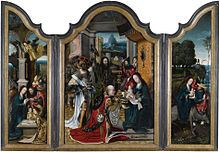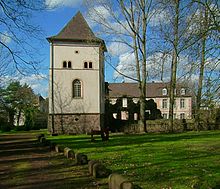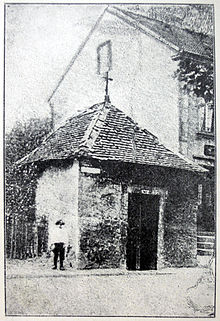Dillinger triptych

The Dillinger Triptych is an altarpiece from the early 16th century that is ascribed to a previously unknown Dutch master. It is considered one of the most valued works of art in Saarland.
The triptych originally comes from the chapel in Dillingen Castle . The theme of the middle altarpiece is "Adoration of the Child by the Three Wise Men". The left wing represents the Annunciation to Mary by the Archangel Gabriel , the right wing the birth of Jesus in Bethlehem . The work was restored in the early 1960s. At Christmas time it is publicly displayed in the Saardom .
Dimensions
The 88 cm high and 56 or 26 cm wide wooden panels join together to form a relatively small-format altarpiece, which - without design on the outside - is obviously not intended for a large church, but rather for private use or for installation in small chapels Was intended for prayer rooms.
Authorship
Research has long been concerned with two fundamental questions. They relate to the authorship and origin of the work of art. What is certain is at least that the unknown artist , who is not identified by any signature , is a representative of old Dutch painting , with different names appearing in research.
Presumed authorship of Lucas van Leyden
For a long time the work was attributed to the painter and engraver Lucas van Leyden . It goes back to the Palatinate theologian and art historian Franz Klimm (1881–1952). In the Dillinger altarpiece, Klimm saw an early work by the Dutch artist from the period between 1516 and 1520 and related it to a work by Van Leyden from 1517, which is kept in Munich. It remains unclear, however, which picture by the Dutchman is supposed to be the dating of the two cannot be related to the very precise time 1517. While the representation “Mary with the Child, St. Mary Magdalene and a Donor”, originally conceived as a diptych , bears the year 1522, the “Annunciation to Mary”, which adorned the back of the right wing of the altar until 1874, is neither dated nor signed. The painting is generally dated to the first third of the 16th century.
Since the few surviving paintings by van Leyden are mostly undated and also not uniform in quality, it is difficult to establish a coherent chronology of his painterly oeuvre.
Investigations by Marie-Luise Hauck
Taking up the thesis of Lucas van Leyden's authorship, Marie Luise Hauck made stylistic comparisons between the painting in the Holy Sacrament and three thematically related altar panels by the Dutchman from the first half of the 16th century in an article published in the Saarheimat magazine in 1961 on. The works selected by Hauck for comparison are, on the one hand, the central painting of a winged altar with the "Adoration of the Magi '' from the Barnes Foundation in Merion / Philadelphia (around 1510), and also an altarpiece on the same subject from the Ryerson Collection in Chicago (around 1519) and finally the above-mentioned diptych from the Alte Pinakothek in Munich with the depiction of the “Annunciation” (1522).
Here the art historian observes certain similarities in the design of the picture background as well as in the arrangement of the three main characters and - especially in comparison with the altarpiece from the Ryerson Collection in Chicago - establishes some "similarities in the details - such as the face and head posture of Mary, Profile of the Moorish King ”. But in the end she comes to the conclusion that there are “differences rather than similarities” between the work of the Dutch painter and that of the master of the Dillinger Triptych and, not least because of the general difficulty, holds the oeuvre of the artist from Leiden unambiguously for "impossible to prove his authorship."
At best , Marie-Luise admits “a resemblance” to artists such as Quentin Massys (1466–1530), Herri met de Bles (around 1520), Gerard David (1450–1460) or Rogier van der Weyden (1399 / 1400–1464) Hauck an assignment to another of the numerous painters of the time was problematic. Accordingly, the researcher also questions Walther Zimmermann's assumption that the master of the Dillinger triptych should be close to a representative of the Brussels School who succeeded Bernard van Orley .
Presumed authorship of the circle of Pieter Coecke van Aelst
However, Walther Zimmermann's reference to the Brussels School leads to another painter who is associated with the Dillinger Triptych: Pieter Coecke van Aelst from Belgium . Coecke's reredos “Adoration of the Kings”, which was probably made around 1540 and is in the possession of the State Museums in Berlin, shows similarities with the Dillingen winged altar.
In the Dillinger picture the painter has moved the people even closer to the front edge of the picture. In this way he not only underlines the intimacy of the scene, but also creates a great closeness to the believers. Only the low bench that appears at the bottom of the picture maintains a certain distance from mother and child.
The viewer's attention is drawn directly to the bright incarnates of the three main characters: Mary, seated in the foreground, who offers the Christ Child as homage to the sage kneeling at the bottom left. The portrayed are involved in a close network of relationships. The left arm of the Mother of God points to the figure of Jesus presented in the center of the representation, whose outstretched right arm leads over to the kneeling magician. The figure of the colored magician rises up right behind it. The stranger depicted in armor points his head towards the center of the picture, where the figure of the third sage bends towards him. The painter rounds off the circular composition with the figure of Joseph . The carpenter's head, facing inwards, brings the intimate group together. Immediately behind it stretches, almost seamlessly, a remote landscape with a homely character. The representations on the side panels are also focused on the central event: the two diagonally directed figures of Mary flank the Mother of God appearing on the central panel. As the only one of the three virgins, Mary in the natal scene wears a red cloak, which is also particularly emphasized among the other figures, who are mainly dressed in blue.
Despite clear correspondences in composition and furnishings, fundamental differences can be observed between the two panels in Dillingen and Berlin. Above all, they concern the design of figures and rooms. The comparatively simple Dillinger devotional image is more strictly oriented towards the contemplative moment of veneration of Jesus. The portrayed have come together to form a dense structure. In the Berlin version, on the other hand, the loosely connected group, arranged in a circle, describes a kind of inner space that also includes the middle ground. Perceived more as individual figures, the people form distances between themselves, but still remain connected to one another through lively gestures and looks.
According to these observations, it seems difficult to relate the image conception of the “Dillinger Adoration” to the personal style of Pieter Coecke; this alone due to the figures, which the Berlin in their gestural restraint from the emotional choppiness of the more active in space figures altarpiece differ. Nevertheless, there are reasons to move the triptych closer to the Flemish painter, whose work “no longer has a fixed center as with the great masters of the 15th century, in the sense of a core of handwritten works, but rather through the stylistic phenomenon of a broad workshop- Production is determined ”. As a busy artist and manager of a large company, Coecke van Aelst was dependent on the support of the workshop when carrying out his orders, which resulted in a certain stylistic variety in the implementation of the image specifications.
Some paintings are known from the circle of the master, which appear closely related to the winged altar from Dillingen not only because of their subject matter, but also in terms of form . This includes the central panel of a triptych from the holdings of the Amsterdam Rijksmuseum . The 88 cm × 123 cm oil painting is dated between 1520 and 1550.
The sketch of the “Adoration” kept in the Rijksmuseum Amsterdam is repeated in a surprisingly similar way on another altar painting, which is attributed to the close circle of Pieter Coecke. It is also the middle part of a triptych (89 cm × 57 cm) with the depiction of "Adoration"; it is now kept in a private collection. The close-knit main group with Mary, Jesus and the two magicians fits into an almost identical composition scheme. The equipment of the depicted and the design of the landscape shown in the background are very similar. However, the formation of the figures, which appear somewhat narrower than those of the Amsterdam table, appears to be different.
Obviously, the “Adoration of the Magi” was one of the more frequent pictorial themes in Pieter Coecke's workshop. As Georges Marlier points out, the numerous variations of worship - partly executed by Coecke himself, partly preserved as workshop replicas - ultimately go back to the pictorial compositions of his teacher Jan van Dornicke , with whose workshop Coecke had been closely associated from a young age.
The Koblenz duplicate
The sacramental altar of the Koblenz Church of Our Lady contains a triptych, the side wings of which are dated to 1564. The triptych is attributed to the so-called Master of the Prodigal Son . With "Master of the Prodigal Son" a painter of the High Renaissance is called. The artist, who is not known by name, was active in Antwerp around 1530 or 1560. He got his emergency name after his picture of the feast for the returning son, a motif from the parable of the prodigal son .
The middle section of the Koblenz Triptych is an exact copy of the middle section of the Dillinger Triptych. The connection between the two works has not yet been clarified.
origin
The origin of the triptych has not yet been clarified, sources that prove how and when the picture came to Dillingen are not yet known. Research therefore relies on conjecture and oral tradition. Walther Zimmermann considers the possibility that the altar once came to Dillingen on the trade route.
Most authors, however, propose a different thesis. According to this, the image is said to have been brought with them towards the end of the 17th century by those ironworkers from the area around Liège who, recruited by the Lenoncourt , had found employment in the Saarland ironworks. Possibly passed into the possession of the hut via the foreign workers, the devotional image was subsequently part of the furnishings of the Dillingen castle chapel. It was probably donated to the pastor Johann Michael Theis in 1787. After his death in 1804, the painting was given to the Catholic parish in Dillingen and hung in the choir of the old Luzienkirche until 1846. Moved to the Odile Chapel towards the end of the 19th century, after its demolition (1912) it was moved to the Saardom, which was completed in 1913 .
After that it was considered missing for a long time until it was found again in the 1950s by Pastor Alois Winkel in a badly damaged condition "in the attic".
State of preservation
In view of the many detours via which the Dillinger triptych reached the Saardom, it is not surprising that the work of art has suffered not inconsiderable injuries over time. As early as 1934, Walther Zimmermann stated in his book on The Art Monuments of the Ottweiler and Saarlouis Districts that the small altar had "suffered a lot from the effects of heat", and around twenty years later the painter Ernst Sonnet (1906–1978) from Güdingen complained ) the “disintegrating state” of the painting. Sonnet, who repaired the triptych for the first time in 1954/55, explains in his “Report on the restoration of the three-part altarpiece in Dillingen” of March 12, 1955, the numerous damage that the painting had suffered over the years. Cracks and cracks in the wooden panels, the paint layer that has been loosened by moisture and sometimes even flaked off, and, above all, the overpainting of the central part are mentioned. Sonnet describes the restoration in detail. The primary goal was "to make the original visible again in as good a way as possible, to remove later ingredients that falsify, to restore the state of preservation and, if necessary, to supplement defects in such a way that the original image appears to be restored."
In 1995 the picture was restored again in the Episcopal Cathedral and Diocesan Museum in Trier.
Art historical classification
The careful and conscientious preservation and restoration of the original state have created the prerequisites for stylistic considerations. Based on these, the Dillinger Triptych represents a period of upheaval in art history. Marie-Luise Hauck sums it up: “It belongs to the large group of pictorial works that were painted around the turn of the Middle Ages to the modern era - stylistically speaking, from the late Gothic period influenced by Dutch realism and the Renaissance advancing from Italy.” In With its three-part shape, the altarpiece represents a genre that is typical of ancient Dutch painting and corresponds to a form of altarpiece and devotional image that has been varied widely within Western art since the Middle Ages.
Originating in a region that was “one of the richest and most important trading centers in Northern Europe at that time”, the work of art can also be assigned to a geographically and culturally very important environment, especially as the “cities of Antwerp and Brussels that were emerging at this time […] Developed into influential cultural centers alongside Ghent, Leuven and Tournai.
literature
- Max J. Friedländer : From Eyck to Bruegel: Studies on the history of Dutch painting . Berlin: Bard, 1916; DNB 579415848
- Max J. Friedländer: Pieter Coeck, Jan van Scorel . In: Max J. Friedländer: The Old Dutch Painting , Volume 12. Leiden: Sijthoff, 1935; DNB 992325803
- Max J. Friedländer: Lucas van Leyden , ed. by F. Winkler. Berlin: de Gruyter, 1963; DNB 451374363
- Marie-Luise Hauck: The Dillinger Altarpiece, A Work by Lucas van Leyden? In: Saarheimat 1961, Issue 12, pp. 2-9.
- Katholisches Bildungswerk Dillingen-Nalbach eV (Ed.): 100 years of Saardom, Holy Sacrament Dillingen, 1000 years of the parish of Dillingen, commemorative publication for the anniversary of the church consecration on April 25, 2013 . Dillingen 2012, pp. 168-182.
- Manfred Kostka: Catholic parish church of the Holy Sacrament "Saardom" . Dillingen, 2nd expanded and improved edition 1997.
- Wolfgang Krönig: Review of Review of Georges Marlier: La Renaissance flamande, Pieter Coecke d'Alost . In: Kunstchronik 1969, No. 2, pp. 47–57.
- Aloys Lehnert: History of the city of Dillingen / Saar . Dillingen: city administration, 1969; DNB 574 840 966 ; Pp. 620-626.
- Georges Marlier: La Renaissance flamande: Pieter Coecke d'Alost . Brussels 1966.
- Michaela Mazurkiewicz-Wonn: Church of the Holy Sacrament (Saardom) . In: Kunstverein Dillingen in the old castle, Dillingen / Saar (Ed.): Art guide Dillingen / Saar . Dillingen 1999, pp. 18-19.
- Ulrich Meisser, Johannes Hahn: Dillingen . Leipzig: Stadt-Bild-Verlag, 2009; ISBN 978-3-937126-98-2
- Antje-Maria Neuner: The triptych in early Dutch painting, visual language and expressiveness of a form of composition . (= European university publications: series 28, art history, volume 242). Frankfurt am Main [u. a.]: Lang, 1995; ISBN 3-631-49122-0
- Ernst Sonnet: About the restoration of a three-part altarpiece from the 16th century . In: Die Schule, 9th year No. 12, Saarbrücken 1959, pp. 251–258.
- Dieter Steffens: Kings came by unknown routes. The Dillinger Triptychon, the work of a Dutch artist, can be seen in the Saardom from January 6th to 8th . In: Saarbrücker Zeitung, Dillingen regional section, issue of December 27, 2005.
- Walther Zimmermann , Johann Baptist Keune: The art monuments of the Ottweiler and Saarlouis districts . Düsseldorf: Schwann, 1934; DNB 361919506
Individual evidence
- ^ Sonnet: From the Restoration ; P. 252.
- ^ Sonnet: From the Restoration ; P. 258, note 4.
- ^ Hauck: The Dillinger Altarpiece ; Pp. 2-9.
- ^ Hauck: The Dillinger Altarpiece ; P. 9.
- ^ Zimmermann / Keune: Die Kunstdenkmäler ; P. 19.
- ^ Meisser / Hahn: Dillingen ; P. 9.
- ↑ Krönig: Review, p. 47.
- ^ Marlier: La Renaissance flamande ; P. 54.
- ↑ Elisabeth Heitger: The triptych by a Dutch painter of the 17th century in the new sacrament altar of the Koblenz Church of Our Lady . In: Parish letter 115 of the Liebfrauen congregation, Koblenz, Advent 1981, altar consecration.
- ^ Kostka: Das Dillinger Triptychon ; Pp. 178-179. Kostka: Article on the Dillinger Triptych. In: Our homeland, bulletin of the Saarlouis district for culture and landscape, issue 1, 1989, pp. 22-29.
- ^ Zimmermann / Keune: Die Kunstdenkmäler ; P. 19.
- ↑ Steffens: Kings came in unknown ways
- ^ Zimmermann / Keune: Die Kunstdenkmäler ; P. 177.
- ↑ Jörg Sonnet: Traces of the Artist Ernst Sonnet, in: Our homeland, bulletin of the Saarlouis district for culture and landscape, 41st year, issue 3, 2016. pp. 129–133.
- ^ Institute for Current Art in Saarland, Saarlouis, holdings: Sonnet, Ernst, Dossier 1528.
- ^ Sonnet: From the Restoration ; P. 251f.
- ^ Hauck: The Dillinger Altarpiece ; P. 2.
- ↑ Neuner: The Triptych ; P. 22.










